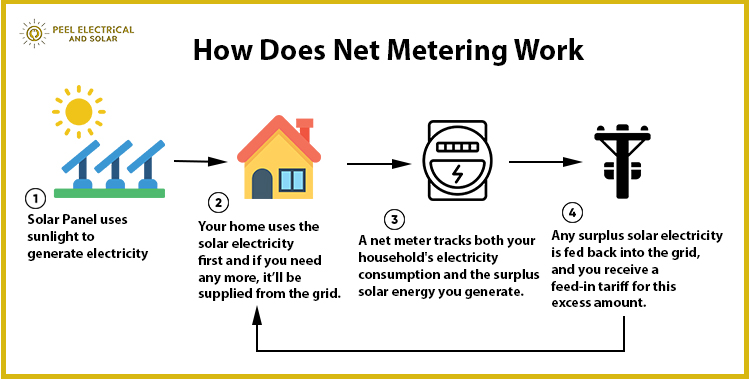Net metering is a crucial billing mechanism that allows homeowners and businesses to offset their electricity costs by feeding excess solar-generated power back into the grid. This comprehensive guide explores the fundamentals of net metering, how it operates, the distinctions between net meters, and the various types of net metering systems available. Additionally, it discusses the benefits and drawbacks of net metering, compares it with gross metering and net billing, and explains key aspects like installation processes and regulatory challenges. Understanding these elements is essential for maximizing the financial and environmental advantages of solar energy adoption.
What is Net Metering?
Net metering is a billing mechanism that allows homeowners and businesses with solar panel systems to feed excess electricity they generate back into the grid. In return, they receive credits that offset the electricity they consume from the grid when their solar system isn’t producing enough power.
How Does Net Metering Work?

Installation of Solar Panels: Solar panels are installed on the property, generating electricity from sunlight.
Electricity Generation: The solar panels produce electricity, which is used to power the home. Any excess electricity generated that isn’t used immediately is sent back to the utility grid.
Dual-Function Meter: A special meter, often called a bi-directional meter, measures both the electricity consumed from the grid and the electricity sent back to the grid. This meter can track energy flowing in both directions.
Credits for Excess Power: When the solar panels produce more electricity than the home consumes, the surplus energy flows back into the grid. The homeowner receives credits for this excess power, typically at a rate equal to the cost of the electricity they would otherwise purchase from the utility.
Offsetting Electricity Costs: During times when the solar panels do not produce enough electricity (e.g., at night or on cloudy days), the homeowner draws electricity from the grid. The credits earned from surplus energy help offset the cost of this electricity.
Monthly Billing: At the end of the billing cycle, the utility company calculates the net amount of electricity consumed versus generated. The homeowner is billed for the net electricity used or may receive a payment or credit if more power was generated than consumed.
What is Net Meter?
A net meter is an electricity meter used in net metering systems to measure the difference between the electricity a home or business generates with its solar panels and the electricity it consumes from the grid.
This meter tracks both the amount of electricity sent to the grid and the amount of electricity drawn from the grid. By calculating the net difference, it allows utility companies to provide accurate billing based on the actual energy usage and the excess energy contributed to the grid.
Types of Net Metering
Standard Net Metering:-
This is the most common type of net metering. The meter runs forward when electricity is drawn from the grid and backward when excess electricity is sent back to the grid.At the end of the billing period, customers are billed for the net amount of electricity consumed (electricity taken from the grid minus electricity sent to the grid).
Net Billing:-
Similar to standard net metering but with a key difference in compensation. The meter tracks electricity sent to the grid separately from the electricity consumed from the grid. Customers are credited for the electricity they send to the grid at a rate different from the rate they pay for electricity consumed from the grid. The credits are applied to the electricity bill.
Time-of-Use (TOU) Net Metering:-
Net metering that incorporates time-of-use rates. The electricity rate varies depending on the time of day, encouraging use when electricity is cheaper and reducing consumption during peak times. Credits for electricity sent to the grid are calculated based on the time it is produced, matching the TOU rates.
Virtual Net Metering (VNM):-
Also known as community net metering. Allows multiple customers or properties to share the output of a single renewable energy system. The generated electricity is allocated among the participants’ electricity bills, reducing each participant’s bill proportionately.
Aggregate Net Metering:-
Allows a single customer to apply net metering credits from one renewable energy system to multiple meters or accounts. Particularly useful for agricultural customers or businesses with multiple properties. Excess generation from one meter can be used to offset consumption on other meters under the same ownership.
Remote Net Metering:-
Similar to aggregate net metering but typically used for customers with non-adjacent properties. Credits from a renewable energy system located remotely from the customer’s primary property can be applied to the customer’s electricity bill. Often used by municipalities, school districts, or large companies with multiple locations.
Feed-in Tariff (FiT):-
Not traditional net metering, but sometimes considered in the context of energy compensation. Customers are paid a fixed rate for all electricity generated by their renewable energy system. The rate is often higher than the retail electricity rate and is set for a long-term contract.
Benefits of Net Metering
1. Cost Savings
Lower Electricity Bills: Homeowners and businesses can reduce their electricity bills by generating their own power and receiving credit for excess energy sent back to the grid.
2. Energy Independence
Reduced Reliance on Grid: By generating their own electricity, customers are less dependent on the grid and less vulnerable to power outages and rate increases.
3. Environmental Impact
Reduced Carbon Footprint: Net metering encourages the use of renewable energy sources, which helps to reduce greenhouse gas emissions and counter climate change.
4. Increased Renewable Energy Adoption
Incentive to Invest in Renewables: The financial benefits of net metering make it more attractive for homeowners and businesses to invest in solar panels.
5. Grid Stability
Distributed Generation: Having more distributed generation sources can enhance grid stability and reduce the need for large, centralized power plants.
6. Economic Benefits
Job Creation: The growth of renewable energy installations can lead to job creation in the solar industry and related fields.
Local Economic Growth: Investing in renewable energy systems can stimulate local economies through increased demand for installation and maintenance services.
7. Efficient Energy Use
Reduced Transmission Losses: Energy generated and consumed locally reduces transmission and distribution losses associated with transporting electricity over long distances.
8. Regulatory Support
Government Incentives: Many regions offer additional incentives and rebates for renewable energy installations, making net metering even more beneficial.
9. Increased Property Value
Higher Resale Value: Properties with renewable energy systems and net metering capabilities often have higher resale values.
10. Encourages Technological Advancements
Innovation in Energy Storage: The popularity of net metering can drive advancements in energy storage technologies, making renewable energy systems more efficient and reliable.
Drawbacks of Net Metering
1. Infrastructure Costs
Grid Maintenance: The utility companies incur costs to maintain the grid, and net metering customers may not contribute adequately to these costs, potentially leading to higher rates for non-net-metering customers.
2. Regulatory Challenges
Policy Variability: Net metering policies can vary widely by region, leading to inconsistencies and uncertainties for homeowners and businesses considering renewable energy investments.
3. Financial Impact on Utilities
Revenue Loss: Utilities may experience reduced revenue as customers generate their own electricity and receive credits for excess energy, which can impact their ability to invest in grid infrastructure and maintenance.
4. Peak Demand Issues
Mismatch of Supply and Demand: Solar power generation typically peaks during the day, which may not align with peak demand times, potentially leading to energy imbalances and the need for additional grid management strategies.
5. Equity Concerns
Cost Shifting: Non-net-metering customers may end up subsidizing the grid costs for net-metering customers, raising equity issues and potentially increasing rates for low-income customers who cannot afford renewable energy systems.
6. Technical Challenges
Grid Stability: High penetration of distributed generation can cause technical challenges related to grid stability, voltage regulation, and power quality, requiring additional investments in grid management technologies.
7. Limited Energy Storage
Dependence on Grid: Without adequate energy storage solutions, net metering customers still rely on the grid for power during non-generating periods, such as nighttime or cloudy days.
8. Administrative Burden
Complex Billing: Net metering requires more complex billing and metering systems, which can increase administrative costs for utilities and complicate the billing process for customers.
9. Market Distortion
Incentive Misalignment: Net metering can create market distortions by providing incentives that do not always align with the true costs and benefits of distributed generation, potentially leading to inefficiencies.
10. Cap on Capacity
Program Limits: Some regions have caps on the amount of net metering capacity allowed, which can limit the number of customers who can benefit from the program and slow the adoption of renewable energy.
Net Metering vs Gross Metering vs Net Billing
Net Metering allows homeowners with solar panels to offset their electricity bills by measuring the difference between the electricity they generate and the electricity they use from the grid. Excess electricity produced by solar panels is sent back to the grid, and homeowners receive credits or compensation for this surplus. These credits can be used to reduce the cost of electricity drawn from the grid when solar production is low.
Gross Metering measures the total electricity generated by solar panels separately from what is consumed from the grid, compensating customers for all the power produced at a fixed rate, while they are billed separately for grid consumption. Both systems are designed to integrate solar power into the energy grid, but they operate on different principles for tracking and compensating energy production.
Net Billing involves measuring and billing electricity separately for what is consumed from the grid and what is exported. In this system, solar energy produced and sent to the grid is compensated at a rate that is often different from the retail rate for electricity. The homeowner is billed for the net amount of electricity they draw from the grid, and credited at a predetermined rate for the energy exported. This approach generally involves two separate transactions: one for purchasing electricity and another for selling excess solar power.
